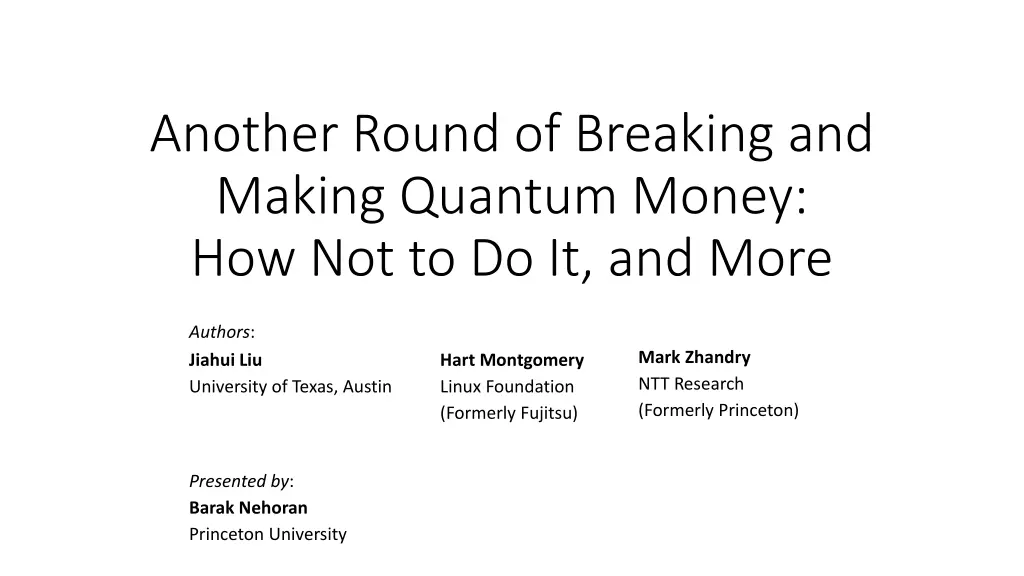
Quantum Money: Breaking and Making Schemes Analysed
Explore the complexities of quantum money with insights from leading researchers like Mark Zhandry, Jiahui Liu, and Hart Montgomery. Discover the challenges in creating secure quantum currency and the ongoing efforts to address them through innovative techniques and theoretical analyses.
Uploaded on | 1 Views
Download Presentation

Please find below an Image/Link to download the presentation.
The content on the website is provided AS IS for your information and personal use only. It may not be sold, licensed, or shared on other websites without obtaining consent from the author. If you encounter any issues during the download, it is possible that the publisher has removed the file from their server.
You are allowed to download the files provided on this website for personal or commercial use, subject to the condition that they are used lawfully. All files are the property of their respective owners.
The content on the website is provided AS IS for your information and personal use only. It may not be sold, licensed, or shared on other websites without obtaining consent from the author.
E N D
Presentation Transcript
Another Round of Breaking and Making Quantum Money: How Not to Do It, and More Authors: Mark Zhandry NTT Research (Formerly Princeton) Jiahui Liu University of Texas, Austin Hart Montgomery Linux Foundation (Formerly Fujitsu) Presented by: Barak Nehoran Princeton University
No-cloning Theorem [Park 70, Wooters-Zurek 82, Dieks 82] Unknown quantum state
Secret key quantum money [Wiesner 70] = No-cloning banknotes unforgeable Problem: only mint can verify
Public key quantum money [Aaronson 09] Public Verification = + Challenge: state information-theoretically known information-theoretically clonable need crypto + quantum info to get no-cloning
(Public Key) Quantum Money is Hard! [Lutomirski-Aaronson-Farhi- Gosset-Hassidim-Kelner-Shor 10] little published cryptanalysis effort [Aaronson 09]: random stabilizer states ? [Farhi-Gosset-Hassidim-Lutomirski-Shor 10]: knots [Pena-Fauge re-Perret 14, Christiano-Sattath 16] [Aaronson-Christiano 12]: polynomials hiding subspaces [Kane 18]: Modular forms ? ? [Bilyk-Doliskani-Gong 22] some analysis [Zhandry 19]: quadradic systems of equations [Roberts 21] [Zhandry 19]: post-quantum iO Post-quantum iO not well understood [Kane-Sharif-Silverberg 21]: Quaternion Algebras ? ? No published cryptanalysis effort [Khesin-Lu-Shor 22]: lattices No (prior) cryptanalysis effort
This Work: Breaking and making quantum money Attack on general class of lattice-based schemes Walkable Invariant framework + analysis New candidate walkable invariants [Khesin-Lu-Shor 22] is insecure Identify sufficient conditions for [FGHLS 12] to be secure Approach to building quantum money from isogenies (unclear if conditions met) (one crucial missing piece)
How Not To Build Quantum Money
A lattice-based proposal (folklore) Verification key (aka serial number) = y A ,
Attack ( consequence of [Liu-Zhandry 19] ) short x s.t. A.x = y measure = = 1 2 Thm [Liu-Zhandry 19]: LWE + super-poly q SIS hash function is collapsing Cor: Attack fools any efficient verification procedure
A more general proposal Verification key (aka serial number) = y A ,
A more general proposal Verification key (aka serial number) = s1 s2 , y A , , , Example: can re-interpret [Khesin-Lu-Shor 22] in this form Trapdoors for A, help with verification = short
Attack (this work) s1 s2 y A , , , , short x s.t. A.x = y = 1, 2 Thm (this work): 1. LWE +any q fools any efficient verification 2. Efficiently construct fake money state from x in many natural settings Cor: Scheme from [Khesin-Lu-Shor 22] is insecure Along the way, improve known results about k-LWE problem
Walkable Invariant Framework (abstraction of [FGHLS 12])
The Walkable Invariant Framework Invariant I: X Y Y X
The Walkable Invariant Framework Invariant I: X Y Y X Permutations
The Walkable Invariant Framework Invariant I: X Y Y X Permutations I( i(x)) = I(x)
The Walkable Invariant Framework Invariant I: X Y Y Permutations I( i(x)) = I(x)
The Walkable Invariant Framework Invariant I: X Y Y for random y 1. Creates uniform superposition over X 2. Measure I(x) : Mint
The Walkable Invariant Framework Invariant I: X Y Y for random y 1. Test that support is on x s.t. I(x)=y 2. Test that state is unchanged under action by i : Public Verification Use a version of the swap test
Recipe for Quantum Money from Invariants Random walk by i mixes + Thm (this work) Secure quantum money Hard path-finding + Knowledge of Path
Hardness of Path-finding Given random x1, x2 with same invariant, hard to compute a path = i1, i2,
Knowledge of Path Impossible to generate x1, x2 with same invariant without knowing path
Applying to Quantum Money from Knots [FGHLS12] Previously: security merely conjectured, with minimal analysis. This framework allows justifying security. X = knot diagrams Hard path-finding I(x) = Alexander polynomial i = Reidemeister moves appear plausible Knowledge of Path Random walk by i mixes unclear Image credit: [Vologodskii 06] Image credit: Wikimedia
Isogenies over (supersingular) elliptic curves Path finding = computing isogenies, widely believe to be hard Knowledge of Path = analog of knowledge of exponent from groups Seems quite plausible, but need more cryptanalysis effort Problem: unknown how to create uniform superposition over X for minting Closely related to major open question of obliviously sampling super-singular elliptic curves
Other instantiations Re-randomizeable Functional Encryption Group actions + classical oracle






















